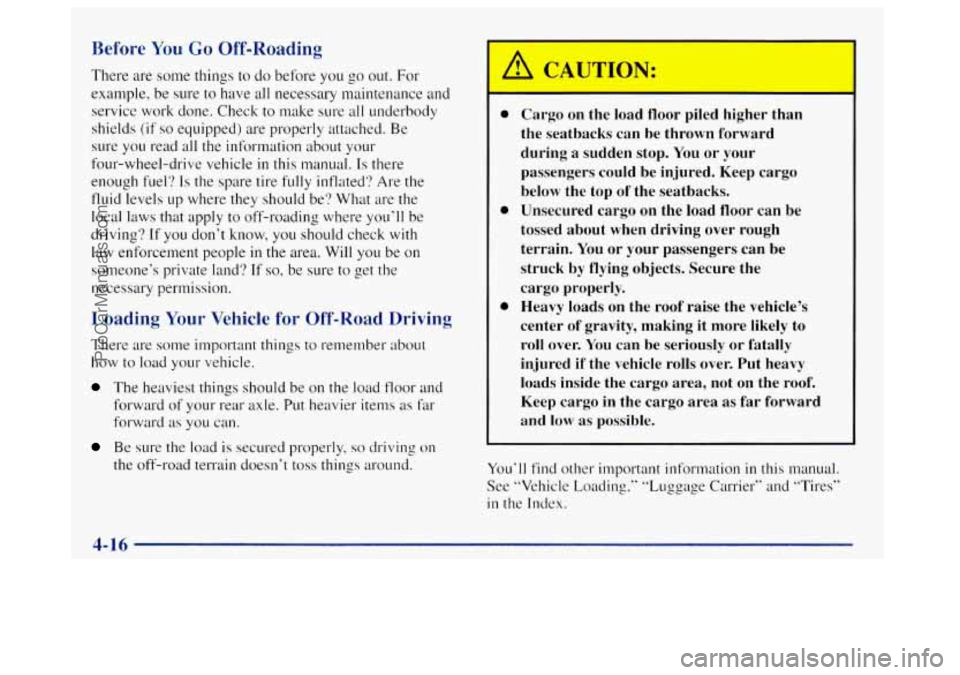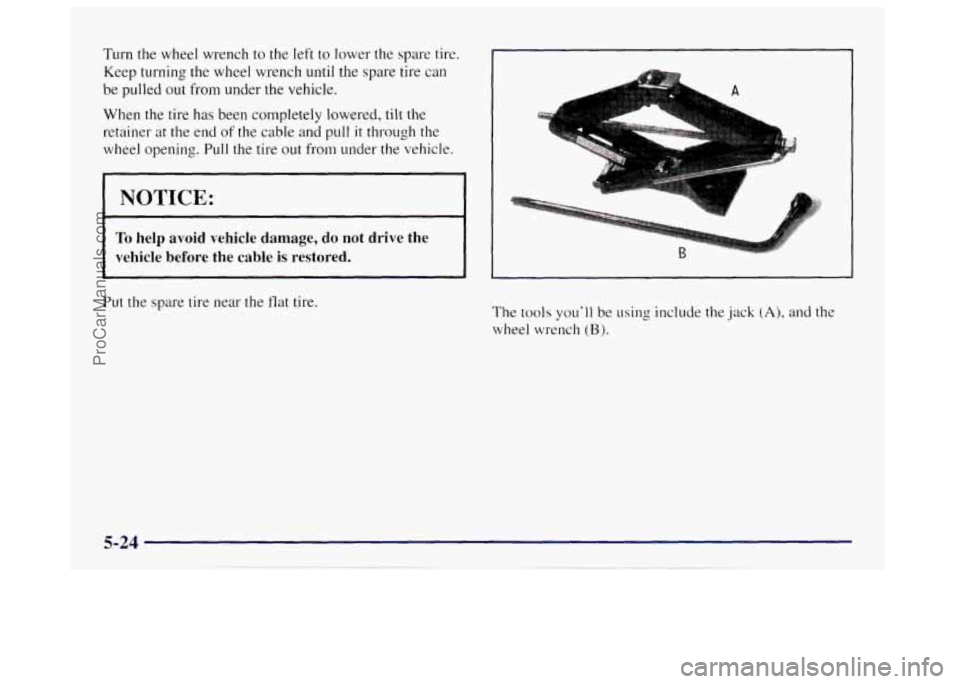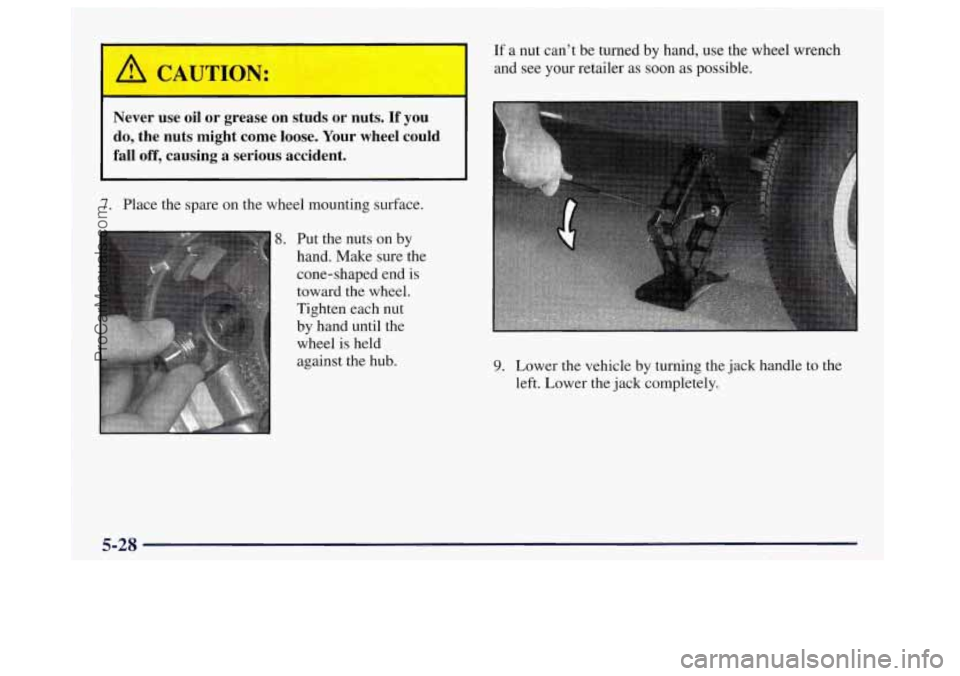spare wheel OLDSMOBILE BRAVADA 1998 Owners Manual
[x] Cancel search | Manufacturer: OLDSMOBILE, Model Year: 1998, Model line: BRAVADA, Model: OLDSMOBILE BRAVADA 1998Pages: 380, PDF Size: 19.2 MB
Page 168 of 380

Before You Go Off-Roading
There are some things to do before you go out. For
example, be sure to have all necessary maintenance and
service work done. Check to make sure all underbody
shields
(if so equipped) are properly attached. Be
sure you read all the information about your
four-wheel-drive vehicle in this manual.
Is there
enough fuel?
Is the spare tire fully inflated? Are the
fluid levels up where they should be? What are the
local laws that apply to off-roading where you’ll be
driving? If you don’t know, you should check with
law enforcement people
in the area. Will you be on
someone’s private land?
If so, be sure to get the
necessary permission.
Loading Your Vehicle for Off-Road Driving
There are some important things to remember about
how to load your vehicle.
The heaviest things should be on the load floor and
forward of your rear axle. Put heavier items as far
forward as you can.
Be sure the load is secured properly, so driving on
the off-road terrain doesn’t toss things around.
~ L, CAUTION:
0
0
0
Cargo on the load floor piled higher than
the seatbacks can be thrown forward
during a sudden stop. You or your
passengers could be injured. Keep cargo
below the top of the seatbacks,
Unsecured cargo on the load floor can be
tossed about when driving over rough
terrain. You or your passengers can be
struck by flying objects. Secure the
cargo properly.
Heavy loads on the roof raise the vehicle’s
center of gravity, making it more likely to
roll over.
You can be seriously or fatally
injured if the vehicle rolls over. Put heavy
loads inside the cargo
area, not on the roof.
Keep cargo in the cargo area
as far forward
and low as possible.
You’ll find other important information
in this manual.
See “Vehicle Loading,” “Luggage Carrier” and “Tires”
in the Index.
4-16
ProCarManuals.com
Page 229 of 380

Removing the Spare Tire and Tools
The jacking equipment you’ll need is stored along the
driver’s rear wall. Your vehicle is also equipped with
work gloves and a plastic ground mat
to assist in the
changing
of a flat tire.
To remove the jack cover,
pull up on the latch(es) on
the cover, Remove the
wheel blocks, jack and
wheel wrench.
The spare tire
is stored under the vehicle.
NOTICE:
Never remove or restow a tire frodto a
stowage position under the vehicle while the
vehicle is supported
by a jack. Always tighten the
tire
fully against the underside of the vehicle
when restowing.
To remove the spare, insert
the chisel end
of the wheel
wrench, on an angle, into the hole
in the rear bumper.
Be sure the chisel end
of the
wheel wrench connects into
the hoist shaft.
ProCarManuals.com
Page 230 of 380

Turn the wheel wrench to the left to lower the spare tire.
Keep turning the wheel wrench until the spare tire can
be pulled out from under the vehicle.
Wflen the tire has been completely lowered,
tilt the
retainer at the end of the cable and
pull it through the
wheel opening.
Pull the tire out from under the vehicle.
~
(NOTICE: I
To help avoid vehicle damage, do not drive the
vehicle before the cable is restored.
I
F
Put the spare tire near the flat tire.
5-24
ProCarManuals.com
Page 231 of 380

Position the chisel end of your wheel wrench in the
notch of the hub cap and pry off the hub cap.
Removing the Flat Tire and Installing the
Spare Tire
1. Using the wheel wrench, loosen all the wheel nuts.
Don't remove them yet.
2. Turn the jack handle to the right (clockwise) to raise
the jack
lift head.
5-25
-
ProCarManuals.com
Page 233 of 380

4. Raise the vehicle by turning the jack handle to the
right. Raise the vehicle far enough off the ground
so
there is enough room for the spare tire to fit.
5. Remove all the wheel nuts and take off the flat tire.
6. Remove any rust or dirt
from the wheel bolts,
mounting surfaces and
spare wheel.
Rust or dirt on the wheel, or on the parts to
which it is fastened, can make the wheel nuts
become loose after
a time. The wheel could come
off and cause an accident. When you change a
wheel, remove any rust or dirt from the places
where the wheel attaches to the vehicle. In an
emergency, you can use
a cloth or a paper towel
to do this; but be sure to use
a scraper or wire
brush later, if you need to, to get all the rust
or
dirt off.
5-27
ProCarManuals.com
Page 234 of 380

I
If a nut can’t be turned by hand, use the wheel wrench
and see your retailer as soon as possible.
Never use oil or grease on studs or nuts. If you
do, the nuts might come loose. Your wheel could
fall
off, causing a serious accident.
7. Place the spare on the wheel mounting surface.
8. Put the nuts on by
hand. Make sure the
cone-shaped end is
toward the wheel.
Tighten each nut
by hand until the
wheel
is held
against the hub.
9. Lower the vehicle by turning the jack handle to the
left. Lower the jack completely.
5-28
ProCarManuals.com
Page 236 of 380

Storing a Flat or Spare Tire and Tools
I
Storing a jack, a tire or other equipment in the
passenger compartment
of the vehicle could
cause injury. In
a sudden stop or collision, loose
equipment could strike someone. Store all these
in the proper place.
NOTICE:
An aluminum wheel with a flat tire should always
be stored under the vehicle with the hoist.
However, storing it that way for an extended
period could damage the wheel.
To avoid this,
have the wheel repaired as soon as possible.
Follow this diagram to store the spare or flat tire.
A. Retainer
B. Valve Stem
(Pointed Down)
C. Spare Tire
D. Spring
E. Wheel Wrench
E Lower
G. Raise
H. Hoist Arm
1. Put the tire on the ground at the rear of the vehicle,
with the valve stem pointed down and to the rear.
2. Pull the retainer through the wheel.
3. Put the chisel end of the wheel wrench, on an angle,
through the hole
in the rear bumper and into the hoist
shaft. Turn the
wheel wrench to the right until the
tire is raised against the underside of the vehicle.
You will hear two "clicks"
when the tire is secure,
but
pull on the tire to make sure.
Return the jack. wheel wrench
and wheel blocks to the
proper location
in your vehicle's rear area. Secure the
items
and replace the jack cover.
5-30
ProCarManuals.com
Page 237 of 380

/-A
L
A. Retainer
B. Rubber Band (Some Models)
C. Work Gloves
D. Mat
E. Jack Storage Cover
E Wheel Blocks
G. Hub Cap Removal Tool (some models)
H. Wheel Wrench
I. Jack
J. Jacking Instructions
A CAUTION: A --
Make sure the tire and carrier are secure.
Driving with the tire or carrier unlatched could
injure pedestrians or damage the vehicle.
Compact Spare Tire (If Equipped)
Although the compact spare tire was fully inflated when
your vehicle was new,
it can lose air after a time.
Check the inflation pressure regularly. It should be
60 psi (420 Wa).
After installing the compact spare on your vehicle,
you should stop as
soon as possible and make sure
your spare tire is correctly inflated. The compact spare
is made to perform well at speeds up to
65 mph
(105 km/h) for distances up to 3,000 miles (5 000 km),
so you can finish your trip and have your full-size tire
repaired or replaced where you want. Of course, it’s best
to replace your spare with a full-size tire as soon as you
can. Your spare will last longer and be in good shape in
case you need it again.
5-31
ProCarManuals.com
Page 238 of 380

b
NOTICE:
When the compact spare is installed, don’t take
your vehicle through an automatic car wash with
guide rails. The compact spare can get caught on
the rails. That can damage the tire and wheel,
and maybe other parts
of your vehicle.
Don’t use your compact spare on other vehicles.
And don’t
mix your compact spare tire or wl~eel with
other wheels or tires. They won’t fit. Keep your spare
tire and its wheel together.
NOTICE:
Tire chains won’t fit your compact spare. Using
them can damage your vehicle and can damage
the chains too. Don’t use tire chains on your
compact spare.
If You’re Stuck: In Sand, Mud,
Ice or Snow
What you don‘t want to do when your vehicle is stuck is
to spin your wheels too fast. The method known
as
“rocking” can help you get out when you‘re stuck. but
you must use caution.
If you let your tires spin at high speed, they can
explode, and you or others could be in,jured. And,
the transmission or other parts
of the vehicle can
overheat. That could cause an engine
compartment fire or other damage. When you’re
stuck, spin the wheels as little as possible. Don’t
spin the wheels above 35 mph
(55 kmh) as shown
on the speedometer.
5-32
ProCarManuals.com
Page 281 of 380

Tire Inspection and Rotation
Tires should be rotated every 6,000 to 8,000 miles
(10 000 to I3 000 km). Any time you notice unusual
wear, rotate your tires as
soon as possible and check
wheel alignment. Also check for damaged tires or
wheels. See “When
It’s Time for New Tires” and
“Wheel Replacement” later
in this section for
more information.
The purpose of regular rotation is to achieve more
lrniform wear for all tires on the vehicle. The first
rotation is the most important. See ”Scheduled
Maintenance Services”
in the Index for scheduled
rotation intervals. When rotating your
tires, always use the correct rotation
pattern shown here.
If your vehicle has a compact spare tire, don’t include it
in your tire rotation.
After the tires have been rotated, adjust the front and
rear inflation pressures as shown
on the
CertificatiodTire label. Make certain that all wheel nuts
are properly tightened. See “Wheel
Nut Torque’‘ in
the Index.
Rust or dirt on a wheel, or on the parts to which
it is fastened, can make wheel nuts become loose
after a time. The wheel could come off and cause
an accident. When you change
a wheel, remove
any rust or dirt from places where the wheel
attaches to the vehicle. In an emergency, you can
use a cloth or a paper towel
to do this; but be
sure to use a scraper or wire brush later, if you
need to, to get all the rust or dirt off. (See
“Changing a Flat Tire” in the Index.)
ProCarManuals.com